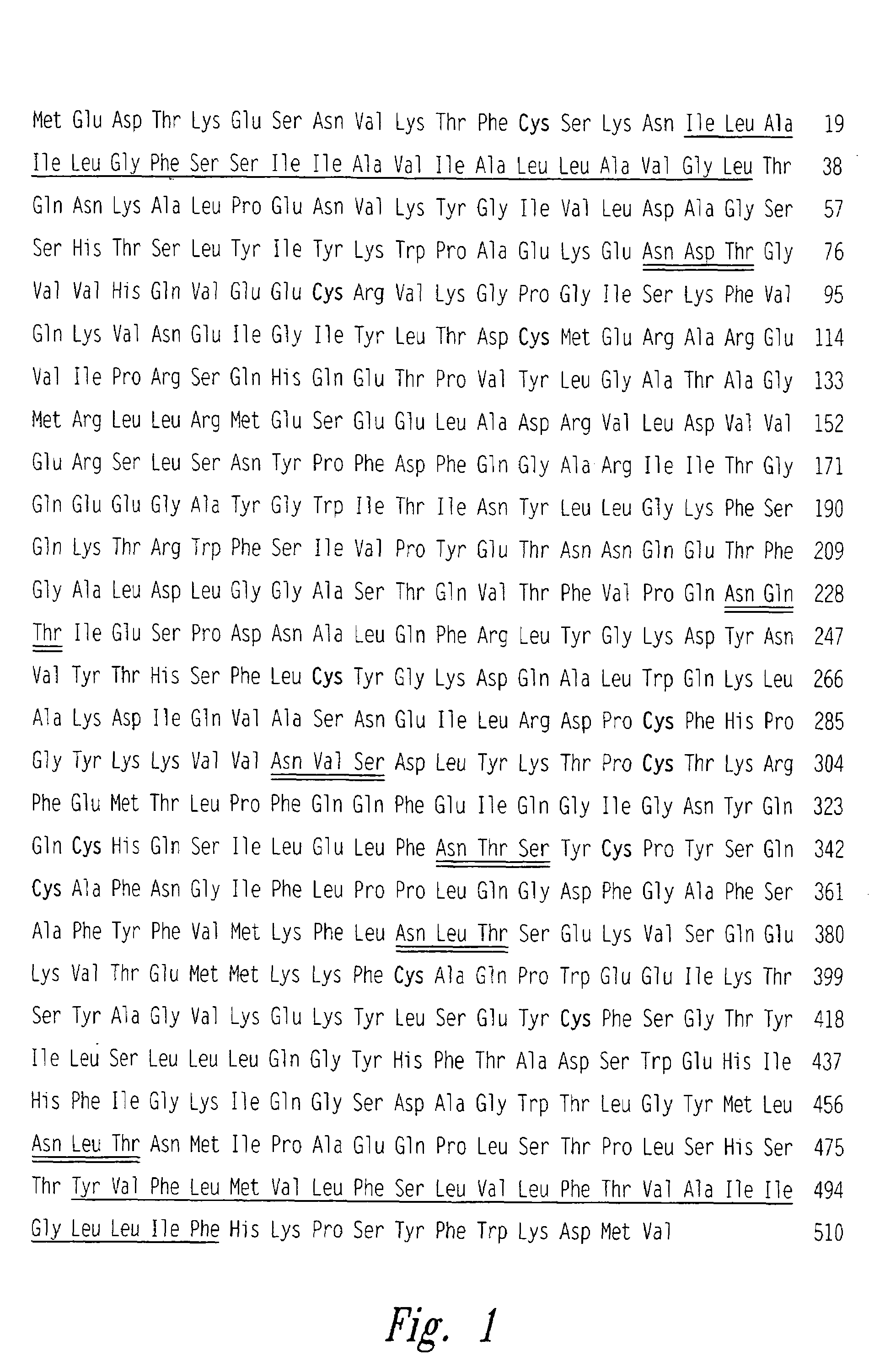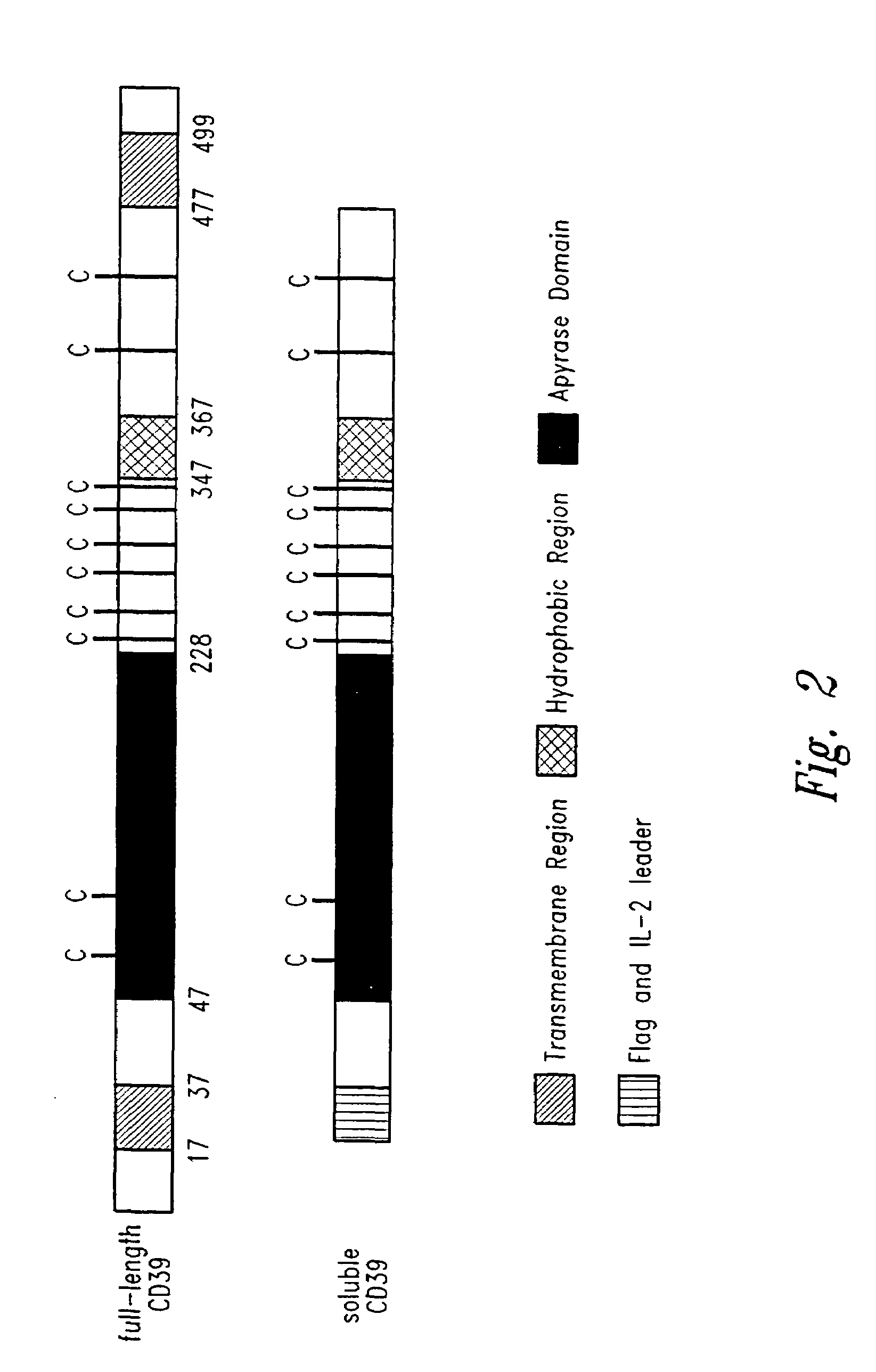Methods of inhibiting platelet activation and recruitment
a technology of platelet activation and inhibition, which is applied in the field recruitment, and achieves the effect of inhibiting platelet activation
- Summary
- Abstract
- Description
- Claims
- Application Information
AI Technical Summary
Benefits of technology
Problems solved by technology
Method used
Image
Examples
example 1
Assay For CD39 Expression
[0128]This example describes the use of a monoclonal antibody in a FACS assay to analyze expression of CD39. The B73 mAb, a monoclonal anti-CD39, is a murine IgG1 that was derived from BALB / c mice immunized with the RPMI 1788 cell line (Rector et al., Immunology 55:481, 1985) and characterized as CD39-specific by flow cytometric analysis and immunoprecipitation / SDS-PAGE. Monoclonal anti-CD39 is purified from ascites fluid by affinity chromatography using a protein A column, eluted with 0.05 M sodium citrate, pH 3.0, neutralized and stored a 4° C. at a concentration of about 1 mg / ml.
[0129]Cells to be analyzed (e.g., MP-1 cells, U937 cells, U937 cells stimulated with 5 ng / ml phorbol myristate acetate (PMA), or Daudi cells) are suspended to a concentration of 106 cell in 50 μl of phosphate buffered saline (PBS) containing 100 μg / ml human IgG1, and incubated for 30 minutes. The cells are then pelleted by centrifugation, resuspended in PBS / azide containing a firs...
example 2
Immunoselection of Cells Expressing CD39
[0130]This example describes a panning (immunoselection) technique for cells expressing CD39. For the preparation of pan plates, purified anti-CD39 or control antibody is diluted in phosphate buffered saline containing 0.1% heat-inactivated fetal calf serum (PBS / FCS). A titration of anti-CD39 can be performed to determine the most effective concentration of anti-CD39. Pan plates are prepared by adding three ml of antibody solution or PBS / FCS alone to each plate. The plates are incubated for approximately one hour at room temperature, washed five times with PBS / FCS, and three ml of PBS / FCS containing 0.02% sodium azide are added to each plate.
[0131]The cells to be analyzed (e.g., MP-1, U937, or Daudi cells) are suspended in PBS / 500 μM EDTA / 0.02% sodium azide (PEA) containing 5% goat serum, 5% rabbit serum and 100 μg / ml human IgG1, to a concentration of 2×106 cells / ml; 500 μl of each cell suspension is added to the prepared pan plates. The pan p...
example 3
cDNA Library Construction
[0132]This example describes preparation of a cDNA library from a human B cell line referred to as MP-1, for expression cloning of human CD39.
[0133]The library construction techniques were substantially similar to that described by Ausubel et al., eds., Current Protocols In Molecular Biology, Vol. 1, 1987. Briefly, total RNA was extracted from 8M guanidine HCl-lysed MP-1 cell cultures using differential ethanol precipitation and poly (A)+ mRNA was isolated and enriched by oligo dT cellulose chromatography. Double-stranded cDNA was made from an RNA template substantially as described by Gubler et al., Gene 25:263, 1983. Poly(A)+ mRNA fragments were converted to RNA-cDNA hybrids using reverse transcriptase primed with random hexanucleotides. The RNA-cDNA hybrids were then converted into double-stranded cDNA fragments using RNAase H in combination with DNA polymerase I. The resulting double-stranded cDNA was blunt-ended with T4 DNA polymerase.
[0134]Unkinased (i...
PUM
| Property | Measurement | Unit |
|---|---|---|
| pH | aaaaa | aaaaa |
| concentration | aaaaa | aaaaa |
| concentration | aaaaa | aaaaa |
Abstract
Description
Claims
Application Information
 Login to View More
Login to View More - R&D
- Intellectual Property
- Life Sciences
- Materials
- Tech Scout
- Unparalleled Data Quality
- Higher Quality Content
- 60% Fewer Hallucinations
Browse by: Latest US Patents, China's latest patents, Technical Efficacy Thesaurus, Application Domain, Technology Topic, Popular Technical Reports.
© 2025 PatSnap. All rights reserved.Legal|Privacy policy|Modern Slavery Act Transparency Statement|Sitemap|About US| Contact US: help@patsnap.com



